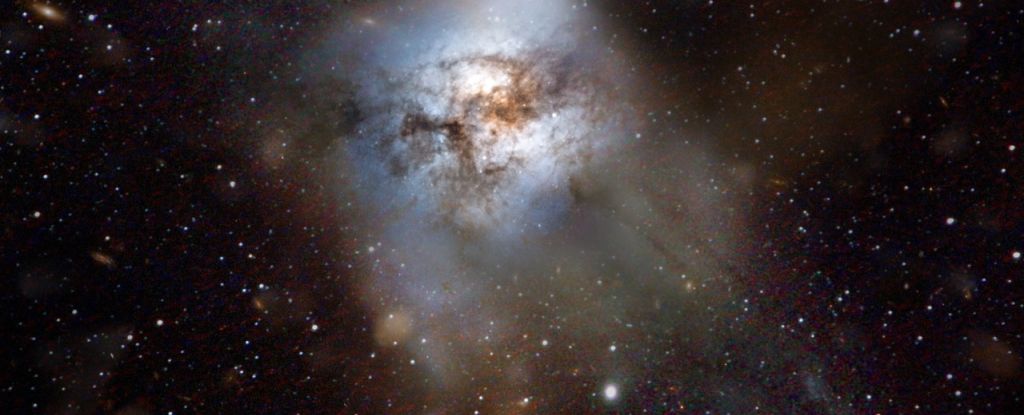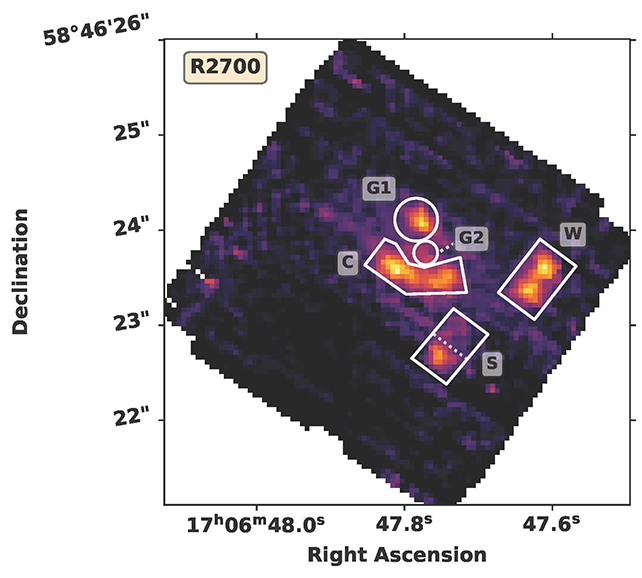
During the initial 2 billion years after the Big Bang, which occurred 13.8 billion years ago, the early Universe experienced intense activity. Star formation was vibrant, galaxies ignited in the darkness, collided, and expanded.
Deciphering the light that traverses vast distances across space and time poses challenges, and our interpretations aren’t always accurate. The currently most potent space telescope in action has recently uncovered what could be a captivating instance of misidentification.
Discovered in 2013 as the origin of intense star formation just 880 million years after the Big Bang, a celestial entity named HFLS3 is not a single galaxy. According to an analysis of data from the James Webb Space Telescope, HFLS3 is a collision involving six galaxies on an epic scale at the dawn of time.
The upcoming publication in Astronomy & Astrophysics, authored by astrophysicist Gareth Jones from the University of Oxford, has been accepted and can be accessed on the preprint server arXiv.
Scientists were perplexed by HFLS3 when they discovered it in Herschel space telescope data. Positioned at the dawn of the Universe during the [Epoch of Reionization], it was actively generating stars at a remarkable rate of approximately 3,000 solar masses per year. In comparison, the Milky Way, thought to have a similar mass, produces around 8 solar masses of stars annually.
Explaining this phenomenon proved challenging, as galaxies were not believed to attain such substantial sizes so early in the Universe or sustain such a high rate of star formation.
However, the observations from Herschel and subsequent Hubble observations hinted that there was more complexity at play, suggesting the possibility of more than one galaxy within that distant glow.
Designed for optimal observations of the deepest realms of space-time with unprecedented resolution, JWST enabled astronomers to scrutinize HFLS3 with greater detail than was previously possible.
In September 2022, JWST’s NIRSpec instrument, specializing in near-infrared observations, captured data from the portion of the sky housing HFLS3. Jones and his team enthusiastically delved into the data. After meticulous processing and deciphering the light’s journey through the Universe, they uncovered indications of six distinct galaxies within.

In a cosmic expanse merely 36,000 light-years in diameter, they discovered that HFLS3 comprises three sets of small galaxies engaged in a celestial dance, propelling them toward an inevitable collision. This collision would have occurred within a billion years of the observation—a remarkably brief period for an event as monumental as a galactic collision.
Proximity is key here—their gravitational interplay is stirring up the material that forms stars, setting off a vibrant burst of star formation. This phenomenon elucidates the exceptionally rapid rate at which new stars are emerging. The revelation provides a captivating glimpse into the interactions and growth of galaxies during the epoch known as the Cosmic Dawn.
The researchers emphasize the need for more in-depth exploration, not only of this source but also of others with similar characteristics.
Taken together, our results require a drastic reinterpretation of the HFLS3 field,
they write in their paper.
HFLS3 is likely not an extreme starburst, but instead represents one of the densest groups of interacting star-forming galaxies within the first billion years of the Universe. Recent and ongoing high-resolution observations … will help to further characterize this unique field.
The study has been approved for publication in Astronomy & Astrophysics and is accessible on the preprint server arXiv.





